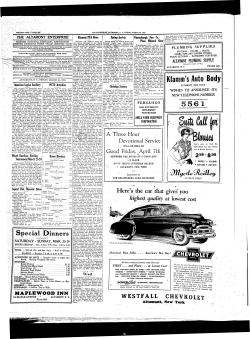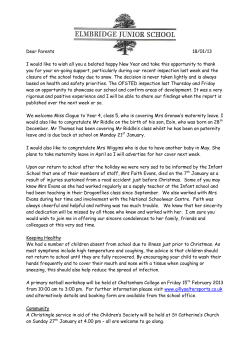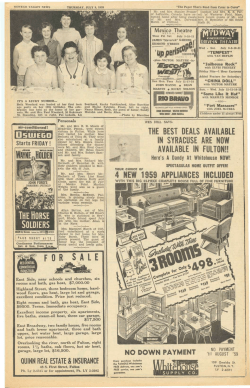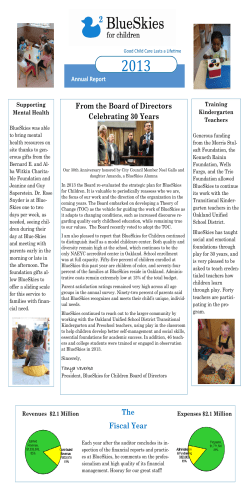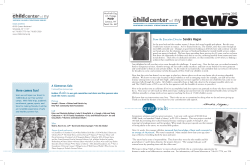
KIDS ’ NEWS
KIDS’ NEWS THE BELGIAN KIDS’ FUND FOR PEDIATRIC RESEARCH & SCIENTIFIC FUND OF THE CHILDREN’S UNIVERSITY HOSPITAL QUEEN FABIOLA KIDS’ CARE THE HUMAN TOUCH THE FRIENDS OF THE CHILDREN’S UNIVERSITY HOSPITAL QUEEN FABIOLA ” A MAN NEVER STANDS AS TALL AS WHEN HE KNEELS TO HELP A CHILD. “ PYTHAGORA EDITORIAL THE CHILDREN’S UNIVERSITY HOSPITAL QUEEN FABIOLA IS 25 YEARS OLD. cardiac function. This is particularly the case after a drowning or after complicated and difficult cardiac surgery. In children born deaf and dumb, miniaturized surgical techniques also allow the placement of a cochlear implant enabling them to hear and to learn to speak normally. Programs of multidisciplinary care in chronic diseases such as cystic fibrosis have increased the average life expectancy of patients by 1.2 years a year each year! This means that patients who died before adolescence now reach adulthood, study and go on to marry and have children. Our institution recently celebrated 25 years: on this occasion, an academic session in the presence of Her Royal Highness Princess Mathilde took place at the Palais des Academies in Brussels. A public hospital is also characterised by the abundance of open consultations (without appointments), representing nearly 35,000 annual consultations: an outstanding service to the population of Brussels. The considerable development of all child care programs can be expressed in a few figures: nearly 150,000 specialty consultations are performed each year in fields as diverse as heart defects, cystic fibrosis, kidney transplantation or diabetes. But it is also a daily training course for budding paediatricians and paediatric specialists, as well as nurses and paramedics. Daily technical feats have increased the life expectancy of our patients, such as for example, extracorporeal membrane oxygenation in resuscitation. This corresponds to an extracorporeal blood circulation with oxygenation in the intensive care unit for children who temporarily have an insufficient lung or Finally, scientific research occupies a privileged place allowing to improve the understanding of diseases that affect our children, but also the treatments that are applied. All of this has resulted in a wonderful three-volume book published by Laconti. This book relates the epic story of paediatrics in Brussels, testifies the impor- tance of all the departments of the hospital to work with children and, finally, shows the remarkable enthusiasm of the teams to create new activities and to develop innovative projects. It’s an emotion comparable to the tremendous tool available to those who are the most precious to us : our children ! Professor Georges CASIMIR YOU WILL FIND OUR BOOK AT FILIGRANES OR DIRECTLY AT THE CHILDREN’S UNIVERSITY HOSPITAL QUEEN FABIOLA. Hardback version: 80€ Softback version: 50€ Secretariat: Mrs. Régine Duchenne Tel. 00322-4773221-024772341 ACTIVITIES BKF A REPORT ON RESEARCH GRANTS For over 15 years, the scientific foundation of our hospital provides scholarships to paediatricians in training. The goals are threefold. First, to give a young doctor the opportunity to work in a research laboratory, to perfect the understanding of complex mechanisms and, to understand how complex research is but also how very exciting it can be. Subsequently, the young doctor will become a major player in education and will pass the torch to future young researchers. He/she will then have the academic profile of a future university teacher, particularly creative and capable of organising an important department. During these years, more than 80 research grants of € 35,000 have allowed to focus on a large number of research topics in extremely varied fields of paediatrics. This work contributed to the publication of scientific articles in international magazines and also to more than 20 doctoral theses. Among the grant holders, a particular mention for Dr. Emily Markessis who worked in the Neurophysiology laboratory of Professor Deltenre. She studied the entire physiology and mechanism of hearing in children as well as in an animal (dog). These studies notably led to the proposal to operate at a much earlier age, children suffering from profound deafness by placing a cochlear implant at the age of one year, enabling the child to learn a language almost normally. Dr. Pierre Smeesters studied the genetic aspects of certain bacteria notably responsible for serious illnesses in children. This analysis was made partly in Belgium and partly in Brazil. It helped to understand the differences in these infections in two countries very far apart and to help understand how to treat them. Dr. Julie Désir studied also at the genetic level, families of patients with microcephaly (small head) and isolated the genes responsible for the phenomenon. Dr. Nelle Lambert studied the identification and characterisation of new genes involved in normal and pathological development of the human cerebral cortex in the laboratory of Professor Pierre Vanderhaegen, while Dr. Joëlle Vermeulen studied the genes responsible for the more or less favorable prognostic of neuroblastoma, a tumor of the adrenal gland in children. An additional mention for Dr. Aline Vuckovic who studied diaphragmatic hernias and the pulmonary consequences of this malformation. Finally, Dr. Nicolas Lefèvre who studied the sexual difference in inflammation demonstrating that girls have a better prognosis for acute infections and a poor prognosis in chronic inflammations, by substantiating the essential role of the X chromosome in the process. We can see the extraordinary variety of themes considered and their utility in treatment programs for children and improved treatment techniques. Professor Georges CASIMIR THE CHILDREN’S UNIVERSITY HOSPITAL QUEEN FABIOLA – MISSION Every day, surgeons at CUHQF carry out difficult operations on newborns as well as on older children: cardiac surgery, digestive, orthopaedic, plastic surgery ... Every day, anxiety grips hearts. Every day, nearly 300 parents bring a child to the CUHQF: every day, around 300 times, an aura of apprehension… Every day nearly 250 children are referred to a specialist at CUHQF: every day, nearly 250 times a day, this means that the paediatrician does not know that it may be something serious… Every day, more often in the winter, a little less in the summer, 70 children are brought to the emergency unit at CUHQF, sometimes by ambulance, sirens blaring: every day, 70 times a day, a child and his parents have a reason to panic… Every day, children come to the hospital for long and potentially painful treatments (in principle, our pain clinic controls this symptom), which are sometimes continued throughout their lives ... Every time, upon the announcement of a life long treatment, a project collapses. Sometimes, unfortunately, medicine is powerless, a child dies, leaving only emptiness in the hands of the parents… The mission of CUHQF is to collect every day, these auras of apprehension, these grips of panic, these deaf concerns and chest-tightening anxieties, the shattered dreams and projects destroyed, and to assist families who have to confront emptiness. Every day, anaesthetists put children to sleep at CUHQF to carry out complex examinations : every day, dozens of times a day, children and their parents feel the dawning of a worry… In order to accomplish the above, the CUHQF can rely on a competent and dedicated medical, nursing and paramedical staff as well as technically advanced equipment. All the staff and all the equipment are, as much as possible, adapted to the sick child, the child in need as well as their families. Every day, at CUHQF, the doctors make serious diagnoses : cancer, cystic fibrosis, orphan disease, congenital disease, heart disease, retarded development… Each time a dream is broken. Public authorities take care, for the most part at least, of the walls, staff salaries, medical equipment, but there is no word , or “refund” as one would say for listening, a hug, for encouragement, for a word of comfort, no more than for a warm environment that allows the child to sometimes forget he is in a hospital. The child must be distracted from his physical pain or mental grief, he must be given the urge to laugh and sing, to grow like any other child, to be allowed to continue to go to school when he is isolated in the hospital ... It would take pages and pages to describe everything the CUHQF should have to meet the needs of sick children and their families in the field of humanisation. Unfortunately there are also other “material” needs, which would be expected to be covered by the public authorities but they remain stranded… some facilities are so expensive, and used too infrequently to be “ profitable “: the word is out. Who would have thought that the word “profitability” would find its place in a text devoted to the sick child? Sponsorship must also sometimes contribute to machines, treatments and complex analysis… All this is possible thanks to heart stopping, generous gestures, a lot of dedication, volunteers who give selflessly to the cause that is the relief of the sick child and his family . The Friends of the Children’s University Hospital Queen Fabiola - Kids’ Care appeal to your generosity so that Children’s Hospital can continue to ease pain and restore life and hope to children and their families. With all my heart, THANK YOU! Professor Philippe GOYENS SIX SCHOLARSHIPS IN 2012! During the year 2012, six new scholarships were awarded by our foundation: namely Catherine Adler who is studying infections presented by children born to mothers with acquired immunodeficiency syndrome (AIDS) in the laboratory of Professor Arnaud Marchand in collaboration with Professor Levy. Simon Baijot is working on environment and alternative care of children suffering from hyperactive and inattention syndrome in collaboration with Professor Bernard Dan. The third scholarship was awarded to Sophie Blumenthal who is studying pneumococcus epidemics and cases of meningitis in the microbiology laboratory of the Children’s Hospital in London. Ariane Willems, in turn, is evaluating the effects of blood trans- fusions on paediatric cardiac surgery with Professor Van der Linden. Bertrand Escalière is developing and optimising bio-computing tools for data analysis of paediatric genetic sequencing with the data centre and the Genetics Laboratory of the Faculty of Medicine of ULB. Finally, Nicolas Lefèvre is studying gender differences in inflammations and in particular genes that may depend on the X chromosome and account for the difference between girls and boys in acute and chronic inflammatory disorders. Professor Georges CASIMIR OUR TAX APPROVAL HAS BEEN RENEWED ! Associations can only survive through donations and, if necessary through legacies. Our science fund (The Belgian Kids’ for Pediatric Research) as well as the humanitarian association (Kids’ Care for Human Touch) are obviously no exception to this rule. For the process to be adapted to donors, the fund must have tax approval to enable deductibility of the donations made. This tax approval must be renewed regularly, the longest duration of provision by the state is six years. Both tax approvals of our foundations have just been renewed for six years and this is great news . This news delights us because it shows both the honesty and the rigor of management in place enabling further action while benefiting from the generosity of an informed public deeply concerned about the well-being of children. Professor Georges CASIMIR BKF KIDS’ CARE TROPHY THE GARDENS OF AYWIERS Each year, Patricia and Alain Limauge organise in the beautiful gardens of the old abbey of Aywiers a meeting of professionals passionate about gardens and visitors who enjoy an enchanting environment. This is where visitors can find numerous exhibitors offering the opportunity to acquire brilliant plants and shrubs! These meetings take place twice a year in the spring and autumn. This is an opportunity for our director, Françoise Timmermans, to create a twoday village for children: real magic games as well as exciting, recreational and informative games. Many of our faithful sponsors are associated It has become a tradition to organise an annual golf tournament to benefit alternately one or another of our foundations thanks to our director and friend, Baron Hervé van Ypersele. The president of the support committee, Count Jean-Pierre Launoit, also generously devotes his time to these organisations, as well as for the Optima Open tournament, bringing together tennis stars in Knokke. It is also worth noting the involvement of Andy Hancock always so effective in making this event a great success. We must also thank Olivier Two new directors This year, two new directors joined the Board of Directors of our scientific foundation: Firstly, Professor Frank Collier, urological surgeon best known for remarkable reconstruction interventions in children with urological and genital abnormalities, and secondly Prince Amaury de Merode. Both of them have honoured us in contributing their enthusiasm and their warm friendship to our work. We are particularly grateful and thank them both. At the recent golf tournament held at the Château d’Ardenne in our favour so remarkably organised with the help of the ever faithful Baron Hervé van Ypersele and Andy Hancock, Prince Amaury de Merode already present and accompanied by the Princess de Merode, his wife, we were rewarded with wonderful raffle prizes and most friendly words. Van Marcke de Lummen and his wife who greeted us in the beautiful surroundings of the Royal Golf Club of the royal castle in the Ardennes. This year, the event was a great success regarding both performance and fun as well as the generous donations to our foundation, totaling more than € 21.000! with this event allowing us to recruit funds which can either pay for scholarships or promote the humanisation of care while we entertain the children and their families. We would like to thank all those who contribute to the success of this event including the many volunteers without whom our foundation would not exist! Professor Georges CASIMIR HEALTH RECORD OBESITY IN CHILDREN: A MAJOR PROBLEM OF PUBLIC HEALTH IN INDUSTRIALISED COUNTRIES. When looking at pictures of primary school classes of the 60’s, we can see that every 10 years an overweight child is added to the class photo. Thus, in the 60s, there was one overweight child per class, in the 70’s, there were two, in the 80’s three and in the 90’s four. Finally, there are now nearly five overweight children in the classes of our elementary schools! This issue of concern for the health of our children is not only due to inadequate dietary habits, it is also the result of a lack of physical activity and sport, particularly important. Indeed, over time particularly harmful eating habits develop, mainly due to a lack of example from parents. Excess sugar, fat, fried foods, but also sugary drinks such as sodas have invaded the shops and places where children consume drinks. In parallel, a lack of activity starts sometimes in very young children who are placed in front of the television, computers or electronic games. At the same time, stressed, they eat cookies or chips. Three hours of inactivity daily can lead to a weight gain of about 1 kg per month in addition to a normal weight increase! Obesity among children is the start of a great challenge for public health in the twenty-first century: it is a global problem affecting many countries with low and middle income, especially in urban areas. The trend towards obesity has increased at a considerable rate: it is estimated that in 2010 the world had more than 42 million overweight children. Nearly 35 million of these children live in developing countries. Overweight and obese children may remain so as they become adults and they are more likely to develop cardiovascular disease or suffer from diabeties. At the present, we have in our consultations insulin dependent diabetic children from the age of seven years. Obesity in children increases the of risk of premature death and disability in adulthood. They may also suffer from musculoskeletal disorders early and especially joint pain or alteration of articular cartilage. Some types of cancer are also linked to excess weight. WHO recognises that increasing prevalence of childhood obesity is the result of changes in society. It is not only a societal and economic change, but also a change in policies implemented in the field of agriculture, transport, urban planning, environment and the preparation and distribution as well as the marketing of food. This problem therefore requires a multidisciplinary approach both in terms of culture and education, but also in terms of politics of supply of different countries and the promotion of physical activity and sport. Some countries have established large-scale plans in an attempt to reduce this type of epidemic. They promoted a high consumption of fruits and vegetables as well as legumes and whole grains. They proposed to limit energy intake from fat and to reduce the consumption of saturated fats in favor of unsaturated fats. They also limited the consumption of sugar, especially in beverages, and promoted moderate to vigorous physical activity at least 60 minutes per day, taking into account the child’s development and involving a variety of activities. Sustained political commitment is essential as well as public and private policies to improve the behavior of citizens. This should involve parents, schools, but also adult education at all levels, including through the mass media (newspapers and television) which is indispensable. Particularly favourable experiences have been noted both in France and Switzerland for example, demonstrating that at the level of a department, such policies have a particularly effective impact in reducing children’s weight and on the quality of their physical health. We must urgently promote such policies in Belgium to avoid major health problems in future adults. Professor Georges CASIMIR INAUGURATION OF THE NEW INTENSIVE CARE UNIT OF THE CHILDREN’S UNIVERSITY HOSPITAL QUEEN FABIOLA. The Children’s University Hospital Queen Fabiola has launched a modern intensive care unit, which positions it as one of the most efficient in Europe. The architecture, the quality of the equipment at a technical level, the modern computerisation of care and the recording of all the parametres give children the best chance for survival for those who are between life and death allowing for recovery in a particularly welcoming environment for the parents and families. More than ever, the ICU welcomes the parents of children even in the most serious and stressful situations: we know that when a child can have his mother or his father beside him, the prognosis for survival is improved. As a forerunner, the unit has welcomed parents since the opening of the hospital. 1700 m2. It offers a built-in bed for parents in each room, a particularly welcoming interior decoration and most importantly, a dynamic and enthusiastic young team of physicians, nurses and paramedics. We will fondly remember the role of the late Annick Marnef, former head of the unit in forming a cohesive team of nurses. The opening of this unit is a tribute to her memory. The initial unit lacked space and over the years it had become obsolete. A large amount of space was gained through the construction of the terraces of the hospital, which were previously not attached to a building, and by the fact that the dialysis unit moved to the fifth floor, we could build a unit that is virtually In addition to the intensive care beds, a small independent unit was added on the same floor, a unit for severely burned victims. The number of severely burned children that that are transferred to us will benefit from a unique and privileged place to be treated under the best conditions. Professor Georges CASIMIR ACTIVITIES KIDS’ CARE IN 2011 Among the many projects supported are the following: The asbl Friends of CUHQF - Kids’ Care - spared no efforts in 2011 to fulfill the mission assigned to it since 1991. This mission promotes the well-being of children in need by supporting efforts to humanize the reception and care of the sick child and his family as well as contributing to the quality of care through support of continuing education for all categories of personnel who deal with sick children, and the acquisition of medical equipment. The expenses of Kids’ Care in 2011, amounted to 291,923.15 euros, a record! Forty-two percent of recurrent expenditures were for humanisation projects. Sixteen and twenty-five percent of expenditures were assigned respectively to the training of personnel and the purchase of medical equipment. Finally, fifteen percent of expenditures were allocated to operating units and clinical laboratories (furniture, computer equipment, etc.).. Operating costs represent less than 2% of the total of the ordinary revenue. - Entertainment of the hospitalised children - Clowns to the hospital “Lapsus Lazuli” - Doctoon (psychological assistance to children in isolation via a local television network) - The transport of children to Disneyland, in collaboration with asbl “Lighter Dreams” - The “garden hospital” project (gardening activities around the school Robert Dubois) - The purchase of games, toys and crafts for different hospital units - Monthly maintenance of the aquariums - Participation in the Circus School, in collaboration with Robert Dubois School and the Department of Child Psychiatry - The refurbishing of waiting rooms - Courses in Brazilian percussion, climbing classes, cooking classes… - The purchase of cameras and video equipment - The acquisition of revalidation equipment - Training for Paramedics: neuro-dyspraxia, sophrology… In 2011, Friends of CUHQF also contributed to the acquisition and maintenance of expensive equipment. Examples include the acquisition for the ENT depart- ment of equipment for the examination of the vestibular function in young children. All this is of course was only made possible owing to the generosity of many donors and sponsors. We sincerely thank you on behalf of all the children who have been treated and followed at CUHQF. With all my heart, THANK YOU! Professor Philippe GOYENS THE FIRST STONE OF THE BUILDING PROFESSOR HENRI VIS The foundations of the new building that will remarkably expand The Children’s University Hospital Queen Fabiola are currently being dug between the main building and the Avenue Jean Joseph Crocq. This new building is essential to the development of our hospital, which today feels particularly cramped in a building that became too small to contain all the activities in development. A one-day surgical hospital will also be associated with this new area and will be equipped with 25 beds. Currently, there are only eight. The entire department of child psychiatry will be installed in this building. Activity potential will be increased by a unit for the care of infants and their mothers in crisis, a one-day hospital for school-age children and a complementary Child Psychiatry unit for older children. Finally, the hospital administration which is now located in a prefabricated building will be hosted on the top floor where two auditoriums of different sizes will be located. The building should be finished in 2014 and therefore will welcome all these new activities. At the same time, a large amount of space will become available in the main building increasing the potential for outpatient consultations which our hospital particularly needs. The building will include an ultra modern operating theatre equipped with a surgical robot for paediatric surgery. This will be one of the first, if not the first in Europe. The new emergency health care unit for children and the consultation will also be located at the street front, at the entrance of the hospital. Professor Henri Steyaert, new head of paediatric surgery, who came to us from the prestigious Centre Lenval in Nice, one of the best in France, will animate our institution in this important field. The maternity and delivery wards will also be assigned to Brugmann Hospital whose activity is growing in this area and it has become the largest in Belgium. Professor Georges CASIMIR In 2012, again at the The Children’s University Hospital Queen Fabiola, Björn Borg took a table tennis lesson with the well-known Belgian champion, JeanMichel Saive who had just returned from the Olympic games in London. Ivanisevic won his second Open Optima tournament. In conclusion, great news for the children and the staff of our institution. OPTIMA OPEN “Unfortunately, a lot of sick children did get an opportunity to go on holiday at the seaside and come and see us at the Optima Open. Because of this, I felt is was important for me to come and meet them here at the hospital to try and put a smile on their faces” explained Björn Borg. In 2011 at the Optima Open tennis tournament, John McEnroe visited our little patients and gave them some good advice for playing Wii games. By their presence, Björn Borg and Jean-Michel Saive expressed their support for the associations Belgian Kids’ Fund (BKF) and Kids’ Care (KC), supported by the Optima Open tournament. For every tournament ticket sold, 1 euro was donated to BKF and KC and a donation of € 10,000 was offered. KIDS’ CARE THANKS CHARITIC ANGEL’S 2012 23.10.1939 - 19.07.2012 STEPHEN P. FREIDBERG A few years ago, Stephen P. Freidberg was the Treasurer of our Science Foundation: to all those who knew him, he is remembered as a wonderful man - intelligent, humorous and generous. He was also the husband of Elizabeth Strauss, dare I say “our magnificent Babeth” who as director put so much energy and creativity in developing the assets and the image of our association. With a degree in International Relations from Stanford, and the Fletcher School of Law and Diplomacy, he completed his studies with a PhD in economics in Geneva. In 1964, he moved to Brussels and worked in the office of the European Communities Washington DC. He then became the Vice President and Director of International Relations of the Chemical Bank, first in Brussels and then in New York. After working as Vice President of Fair Lanes, a company founded by his grandfather, he returned to Brussels to start his own consulting firm in public relations. This is where he contributed, with great dedication and efficiency in the development of the scientific foundation of the Children’s Hospital. Extremely m oved by his death, we present to his wife and all his family our deepest condolences. Professor Georges CASIMIR Sonia Henrion – Angélique Lesaffre – Delphine Laforge – Claire Sauzedde – Antonella Guillou – Bénédicte Couffon – Pascal Rousseau – Frédérique de Saint Perier – Audrey Bossuyt and Hermès – Jean Van Hamme – Catherine Ullens de Schooten – Christophe Croonenberghs – Valérie Bach – Wim Delvoye – Eric Boschman – Jean-Michel Loriers – Pierre Marcolini – Gérald Watelet – Edouard Vermeulen – Arnaud Adida – Diana Barrault – Valérie Jolly – Mathilde Simon – Jérôme Revon – Philippe Farahnick – Alexandre Delhoye – André Abadijan – Pernod Ricard Belgium – Christophe Dufournier – Belfius Private Banking – Frédéric Schneegans – Emilie Dujat – Eric Sauzedde – Emmanuel Henrion – Jérôme Knaepen for their generosity, and FUND BALANCE SHEET OF ”THE BELGIAN KIDS’ FUND FOR PEDIATRIC RESEARCH” FINANCIAL STATEMENTS 2011 Balance sheet as at 31/12/2011 (in euros) 2011 2010 ASSETS Fixed assets Tangible and intangible assets 241 2,181,651 1,865,244 2,682 45 4,878 39 15 57 2,184,393 1,870,218 2011 2010 LIABILITIES 16,776 Holdings as of 31 Dec 2011 Accounts payable Miscellaneous receivables Recievables from inheritances Investments Disposable income Receivable interest 343.370 1,765,100 75.380 302 TOTAL ASSETS 2,184,393 1,8701,218 5,493 REVENUE 2011 Donations Subsidies Miscellaneous shares Donations Other revenue 48,472 35.000 33,785 330,765 589 880 10,919 Suppliers 1,766,880 Fiscal debts 80.811 258 Accrued expenses 2010 TOTAL LIABILITIES EXPENSES 53,385 Research (Grants) 35.000 Fund raising events 50,097 Running costs Depreciation 493 Taxes 154,006 Financial expenses Depreciation on realisation of assets Hertiage allotment TOTAL REVENUE 2010 Holdings Current Assets Financial products Capital gains on realisation of assets 2011 460.410 292,981 TOTAL EXPENSES 99.000 14.430 26.213 241 3,668 134,541 11,557 27.180 241 8,122 196 255 4,845 38,082 316,407 68,413 460.410 292,981 OUR SPECIAL THANKS TO ALL OUR VOLUNTEERS Ines Bally, Olivia Bally, Catherine Bauraind, Yvonne Behiels, Robin Bertrand, Véronique Biglia, Brigitte Boonen, Pascalou Borremans, Jennyfer Broze, Ophélie Broze, Louis Philippe Broze, Eric Cabuy, Francis Canteraine, Christiane Charlent, Franck Depaifve, Jean-Luc Dossche, Léopold Draps, Mary Duchateau, Carlos Faucon, Dominique Fauvarque, Chantal Floor, Carla Floor, Mme Gonzales, Thomas Harckmans, Mrs. Joris, Barbara Kuborn, Mme Lachenal, Friedel Laperre, Fabienne Lenain, Céline Lust, Gauthier Lust, Joelle Mahieu, Marie Majorin, Karin van Marcke de Lummen, Fatima Martins, Philippe Massart, Sylvie Massaux, Danièle van Meerbeeck, Alain Mettens, Marie-Thérèse Minne, Alix Montuir, Apolline Mourlon Beernaert, Gérald Mourlon Beernaert, Sophie Mourlon Beernaert, Dominique Niemegeerts, Sabine Penelle, Mrs. Petit, Marie Pok, Mrs. Quatpers, Danielle Quinart, Hélène de Roubaix, Anne-Christine Roussel, Virginie Remion, Jacqueline Roy, Berrin Saglam, Laurence Schadeck, Dina Scheppens, Rubina Seydel, Mrs. Stockmans, Bernard Struye, Nadine Terlinden, Marc Timmermans, Thomas Timmermans, Virginie Timmermans, Catherine Ullens de Schooten, Catherine Van der Stichelen Rogier, Anne Vieslet HAPPY NEW YEAR 2013 Want to help our children on this occasion? Donate to PUBLISHER This newsletter is a realisation of Laconti Art Editions for the Kid’s Fund for Paediatric Research and Kid’s Care for Human Touch. EDITORS Professor Georges CASIMIR and Professor Philippe GOYENS EDITORIAL COORDINATION Etienne VISART GRAPHIC DESIGN Serge FONTEYNE and Laurence DECOCK, Trait d’Esprit The Belgian Kids’ Fund for Pediatric Research THE BELGIAN KIDS’ FUND Pediatric Research www.belgiankidsfund.be BE 20 3101 2668 8756 - BIC: BBRUBEBB KIDS’ CARE Humanisation www.ami-huderf.be BE 44 3100 7581 1145 - BIC : BBRUBEBB All donations of a minimum of 40 euros are tax deductible. Mrs. Françoise TIMMERMANS, Administrator and Director of BKF/KC Board of Directors BKF: Professor Arsène BURNY, President - Mrs. Jacqueline SIMON, Vice-President - Professor Georges CASIMIR, Secretary - Mr. Robert CAMBERLAIN, Treasurer - Mr. Jacques ANDRE - Professor Samy CADRANEL - Mr. Jean CHRISTIAENS - Professor Frank COLLIER - Mr. Paul DAMBLON - Professor Marc-Henri DE LAET - Mr. Alain DE MUYNCK - Professor Philippe GOYENS - Professor Philippe LEPAGE - Professor Jack LEVY - Mrs. Fatima MARTINS - Prince Amaury de MERODE - Mrs. Catherine ULLENS de SCHOOTEN - Bharon Hervé van YPERSELE de STRIHOU Board of Directors KC: Professor Philippe GOYENS, President - Mr. Alain DE MUYNCK, Vice-President - Mrs. Danielle QUINART, Secretary - Mr. Bernard STRUYE de SWIELANDE, Treasurer - Doctor Walter BURNIAT - Professor George CASIMIR - Mr.Jean CHRISTIAENS - Mr. Bernard de LANTSHEERE - Professor Philippe LEPAGE - Mrs. MarieThérèse MINNE - Mrs. Catherine ULLENQS de SCHOOTEN - Mr. Paul VAESSEN - Mrs. Aline VIS - Mr. Christian WIENER, Vice-President TRANSLATORS Erik SPRINGAEL (NL) and Jacqueline van OSTEN (EN) COPYRIGHT The Belgian Kid’s Fund for Pediatric Research and Kid’s Care for Human Touch PRINTER Hayez Printing S.A. Brussels Printed in Belgium Any reproduction in full or in part is prohibited without the prior consent of the publisher. The Belgian Kid’s Fund for Pediatric Research and Kid’s Care for Human Touch are not Support Committee BKF/KC Count Jean-Pierre de LAUNOIT, President - Countess Christophe d’ANSEMBOURG - Baron Luc BERTRAND - Miss Olivia BORLEE - Baron CARDON de LICHTBUER - Vicomte Etienne DAVIGNON - Mr. Eric DECELLE - Mr. Alain DENEFF - Mr. Arnaud van DOSSELAERE - Mrs. Evelyn GESSLER - Mr. Eric GORIS - Mrs. Hervé HASQUIN-NAHUM - Mr. Michel de LAET DERACHE -Mrs Marie-Douce de SEJOURNET - Countess Sybille de SPOELBERGH - Mr. And Mrs. Alain LIMAUGE - Countess Maurice LIPPENS - Mr. Bernard MARCHANT - Mr. Pierre MARCOLINI - Mrs. Jacqueline MAYENCE - Mr. Bruno PANI - Mrs. Martine PIAGET - Mr. Michel PILETTE - Mrs. Alain QUERTON - Baroness Solange SCHWENNICKE - Mrs. Elisabeth STRAUSS - Mr. Hakan YUKSEL responsible for the photos, illustrations and unsolicited manuscripts or for any errors in the texts.
© Copyright 2026
